December 2025

The global child care market is estimated at US$ 245.1 billion in 2025 and is projected to grow to US$ 427.48 billion by 2035, rising at a compound annual growth rate (CAGR) of 5.72% from 2026 to 2035.
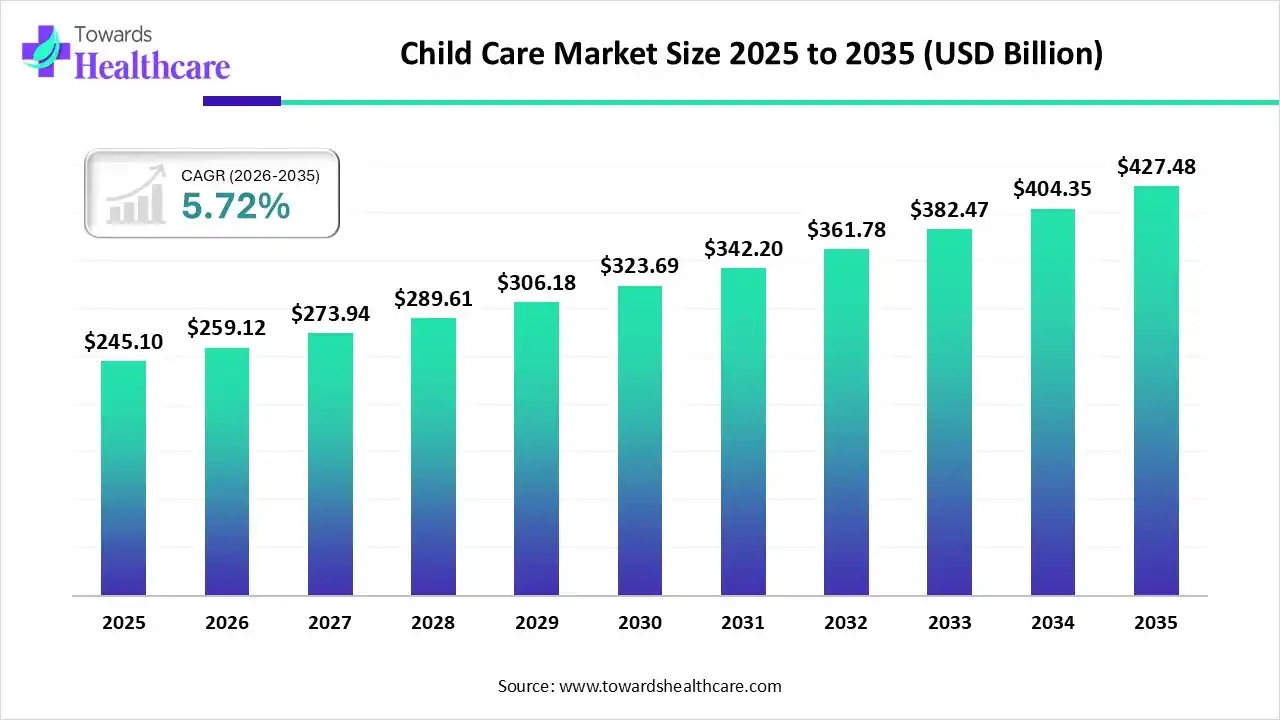
| Metric | Details |
| Market Size in 2026 | USD 259.12 Billion |
| Projected Market Size in 2035 | USD 427.48 Billion |
| CAGR (2025 - 2034) | 5.72% |
| Leading Region | North America |
| Market Segmentation | By Type, By Delivery, By Age Group and By Region |
| Top Key Players | Bright Horizons Family Solutions, SitterTree., LLC, KinderCare Learning Centers LLC., New Horizon Academy, Childcare Network, Goodstart Early Learning, Learning Care Group, Inc., Cadence Education, Spring Education Group, The Learning Experience, Kids 'R' Kids, Primrose Schools, Care.com, BrightPath Kids, Winnie, Inc., Fortune Kindergarten, Goddard Systems, NeighborSchools, Inc. |
Childcare is also known as daycare and is provided to children in the age group 2 weeks to 18 years old. Parents spend certain payments to childcare facilities to provide care to children on an individual or group level. The caregivers are not the parents of the children. From individual to facility level, childcare ensures that children get proper care in the absence of their parents. Childcare providers provide education, conduct activities, conduct social & cultural activities, sports, and other activities for the physical and cognitive development of children. The childcare market is growing due to the growing disposable income, growing interest in nuclear families, and growing number of working women.
As technology develops, daycare facilities are implementing AI solutions to boost productivity, strengthen security protocols, and increase the overall quality of service. Daycare facilities may optimize their operations, cut expenses, and streamline procedures by implementing AI. AI in daycare facilities might have many different forms. AI-powered chatbots, for instance, may be used to respond to questions from parents and offer details on the policies and programs of the center. Using smart sensors and cameras in daycare is another way artificial intelligence is being used. By keeping an eye on kids' activities, these gadgets can guarantee their wellbeing and safety. With the use of AI algorithms, childcare providers may be instantly alerted in real-time when possible threats or strange behavior are detected by analyzing the data gathered by these devices.
For instance,
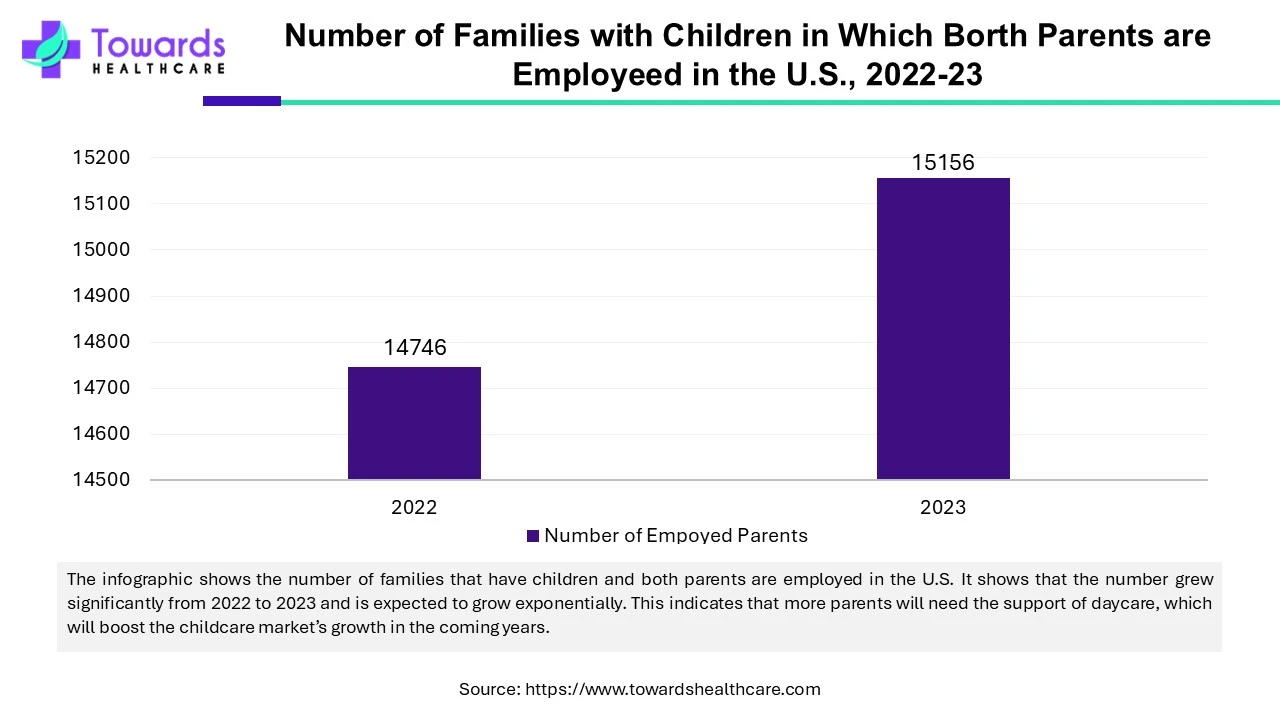
One of the growth factors for the child care market is the growing number of parents. Due to inflation and increasing needs such as better healthcare, better lifestyle, and better education, both the parents in the family work to afford all these things. Due to this, they are unable to focus on their children and need help from childcare/daycare facilities. The childcare providers are well-trained and educated people who ensure that all the needs are fulfilled. Childcare ensures that such children get a proper education, boosts social interaction, and promotes physical and mental development. On the other hand, parents are able to focus on their job and other work.
There are also major regulatory and licensing obstacles that limit the daycare business. To protect the security and welfare of children, daycare facilities must adhere to strict laws and licensing standards. These laws might differ greatly from one area to the next and may contain requirements for staff certifications, child-to-staff ratios, facility standards, health and safety procedures, and educational initiatives. Adhering to these standards can provide a challenge to established providers and create entry obstacles for new ones due to their complexity and expense. The regulatory framework may cause disparities in the standard of care given by various facilities. Navigating these obstacles involves substantial effort and skill, which can limit the formation and expansion of childcare services.
Future childcare needs are inextricably tied to population patterns, especially the projected increase in the number of children. Predictions indicate that the number of children will rise by 24% between 2022 and 2042, highlighting the significant and ongoing need for childcare facilities. Many factors contribute to this rise, such as increased birth rates, better healthcare that lowers infant mortality, and policies that support growing families. The noteworthy increase in the number of children in need of care and education calls for the expansion of childcare facilities and services. There is a potential for investment in new childcare centers and services, fostering innovation in the field. To effectively serve this expanding population, entrepreneurs and established providers need to concentrate on scalable solutions that make use of technology and cutting-edge teaching techniques.
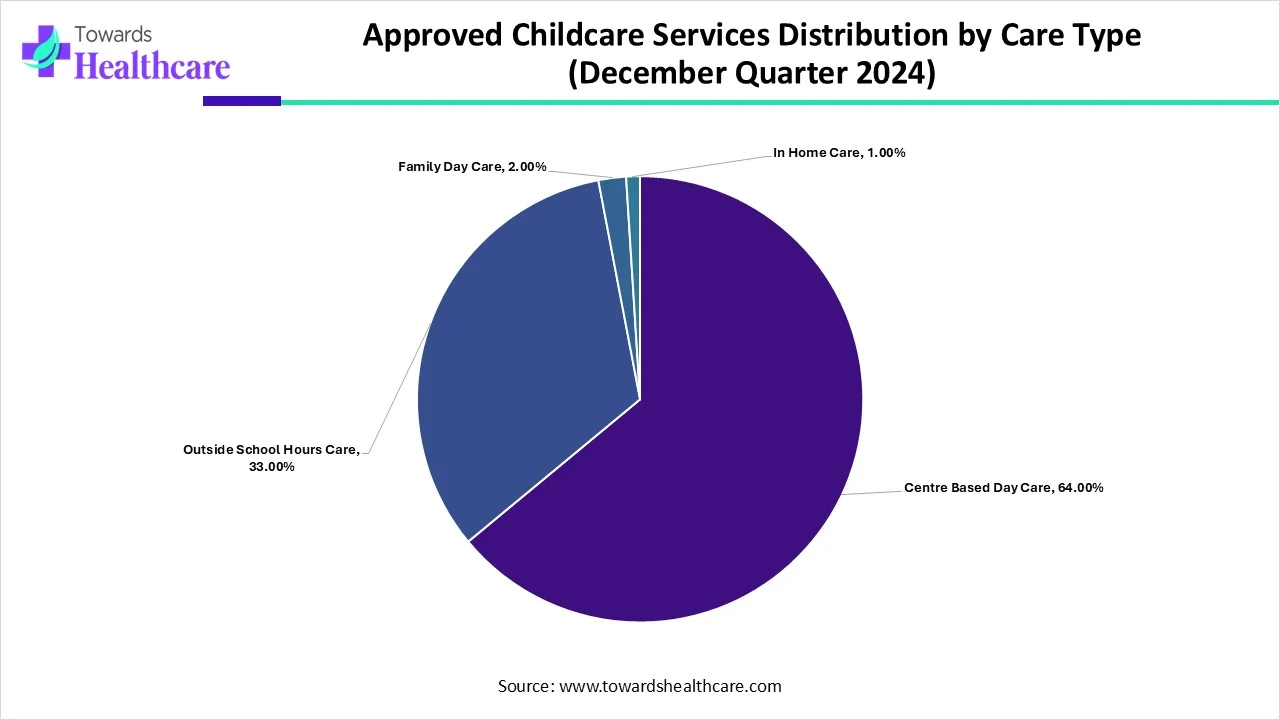
| Care Type | Percentage of Approved Services |
| Centre Based Day Care | 64.00% |
| Outside School Hours Care | 33.00% |
| Family Day Care | 2.00% |
| In Home Care | 1.00% |
By type, the early education & early daycare segment held the dominant share of the market and is estimated to grow at the fastest rate during the forecast period. In many nations, Early Childhood Education and Care (ECEC) has become the standard, with the majority of children aged three and older attending regulated early education programs. Furthermore, early childhood programs are much more than just a place where working parents may leave their children off. However, because it allows kids to participate in a variety of social and educational activities, it plays a significant role in their development. Although even children of stay-at-home mothers are likely to attend some sort of child care, the growing number of children in formal ECEC is largely attributed to two factors: the rise in maternal employment and the convergence of research demonstrating the positive influence of early education on school readiness.
By delivery, the organized care facilities segment dominated the market, and the segment is expected to grow at the fastest rate in the market during the predicted period. Organized childcare facilities are popular among care providers as well as parents. These facilities have several advantages, which makes them a preferable choice. Organized care facilities are government-authorized and have trained professionals who ensure that children do all sorts of activities for growth and development. Organized care facilities are also equipped with the necessary resources to ensure that children learn and grow together. Apart from this, such facilities have children from various cultures, which becomes an opportunity for the children to socialize and learn about different cultures. As many children become a part of such facilities, the cost is also less compared to home-based care facilities.
By age group, the school-aged children segment held the largest share of the market. The service's primary goals are to support kids' overall development and provide child care when parents aren't accessible. One of the ECEC services for children and families that is expanding the quickest is school-aged care (SAC) settings, which are significant contexts of childhood and development. SAC investments are crucial to establishing an accessible and in-line childcare system. Families benefit economically from stable, reasonably priced, high-quality school-age care as it reduces the number of job disruptions parents experience from the absence of before-school, after-school, summer, and non-traditional evening and weekend care. Additionally, as kids become older and their needs vary, it offers them situations that are secure and healthy. Higher pay, better benefits, and more chances for providers to advance professionally can all be supported by these initiatives.
By age group, the infants segment is expected to grow at the fastest rate in the child care market during the forecast period. Infants need proper care and support for growth and development, but due to the growing number of parents focusing on employment, it becomes difficult to take care of the work, house, and children. Therefore, infant care is becoming more and more popular in the society. Urbanization has also promoted the need for infant care. Another factor that contributes to the growth of the segment is the growing switch towards nuclear family due to which parents do not have any support for childcare, and hence, they require help for infant care, which can be taken in the form of a babysitter or via any center. In the future, as the number of children grows due to the increasing birth rate, the demand for infant care will also increase.
By region, North America dominated the child care market in 2023. North America is an advanced region with a lot of working parents, which is one of the leading causes of growing childcare demand. The U.S. and Canada are the largest contributors to the market’s growth.
The U.S. child care market reached a significant size of USD 59.87 billion in 2023 and is projected to experience substantial growth in the coming years. By 2033, the market is expected to climb to USD 88.22 billion, reflecting an impressive expansion. This growth is anticipated to occur at a compound annual growth rate (CAGR) of 4.3% between 2024 and 2033, signaling a strong and sustained demand for child care services throughout the decade.
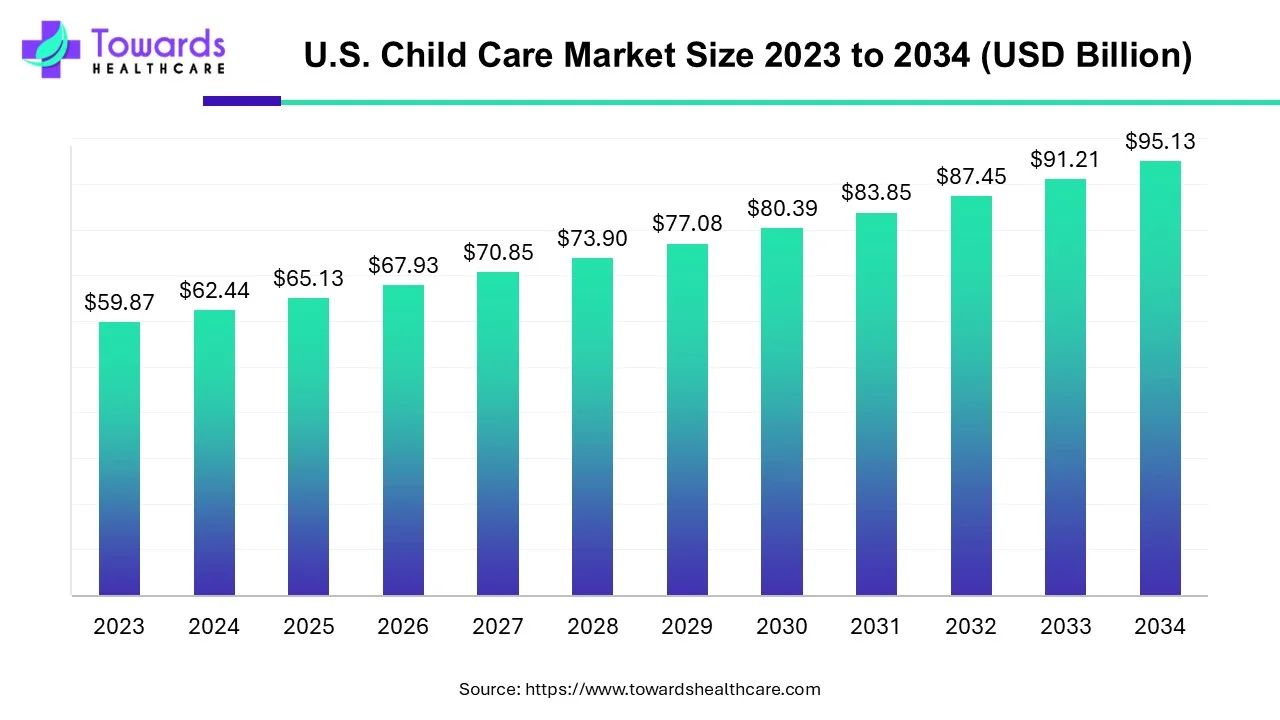
The U.S. dominated the child care market in North America in 2023 due to growing employment. Another significant reason for the growth is due to the growing number of divorced and single parents. The U.S. has a high number of children who live with single parents. In 2023, there were approximately 15.09 million children who were living with single mothers, while 3.05 million children were living with their fathers. This number gives an idea about the number of parent who need childcare facilities in order to work without worrying about their children.
For instance,
Canada is also a significant contributor to the child care market’s growth. For instance, as part of Budget 2021, the Canadian government committed to a game-changing commitment of more than $27 billion spread over five years to collaborate with provinces and territories to establish a childcare and early learning system across the country. Up to $30 billion will be given over five years to assist early learning and child care, when combined with additional expenditures, such as early learning and child care for Indigenous people. Programs for early learning and child care in accordance with the Multilateral Early Learning and Child Care Framework will be supported by this funding.
By region, Asia Pacific is expected to grow at the fastest rate during the forecast period. Asia Pacific has the largest population in the world, which gives a significant advantage for the growth of the childcare market. Apart from this, there is a growing number of parents who are working to fulfill their financial needs. The countries that majorly contribute to the growth of the market are China, India, Japan, and South Korea.
China is known for its advancements and innovation. The nation is a major proponent of children's growth and development. There are currently over 75,000 childcare centers in the nation that can accommodate over 3.6 million children under the age of three. A report given at a session of the Standing Committee of the National People's Congress states that China has continued to improve its childcare service system and will have 4.77 million childcare slots available nationally by the end of 2023. The official Xinhua news agency said that Chinese provinces are pressuring businesses to provide women with flexible labor responsibilities known as "Mama's Posts" that facilitate juggling work and childcare. After China's population declined for a second year in a row in 2023 and birth rates reached a historic low, the government is attempting to encourage more women to become mothers.
Europe is estimated to grow at a significant rate during the forecast period. The child care industry in Europe is characterized by substantial public financing systems, complex regulatory frameworks, and high standards of quality that differ greatly between countries. The main feature of the area is its variety of policy approaches, ranging from Mediterranean nations with higher levels of family engagement to Scandinavian models with extensive state assistance. Creating service upgrades that supplement basic government-funded care with premium features like longer hours, specialist curriculum, or cutting-edge learning tools presents a strategic opportunity for providers.
With a focus on professional credentials and quality requirements for caregivers, Germany dominates the European market. Europe provides stability and operational predictability, with special prospects in work-life balance solutions for corporate personnel, despite its slow growth when compared to growing economies.
Latin America is considered to be a significantly growing area, due to the increasing number of employed people and rising disposable incomes. The rising urbanization and favorable government support contribute to market growth. Adults are concerned about advanced child care amidst an increasing population. The rising number of childcare centers and growing healthcare expenditure foster the market.
Mexico’s birth rate was 16.07 in 2024, an increase of 2.31% from 2023. As of 2024, more than 59 million were employed. The Mexican government launched a new initiative to make child care available to New Mexicans, irrespective of income. This effort makes New Mexico the first state in the nation to guarantee no-cost universal child care.
The birth rate of people in Brazil was 12.58, an increase of 2.09% from 2023. The employment rate in Brazil increased from 58.6% in May 2025 to 58.8% in June 2025. The Brazilian government’s National Integrated Policy for Early Childhood supports the well-being and development of the nation’s youngest children.
Christopher Angellata, CEO of Ohio Child Care Resource and Referral Association, commented on his appointment as the new CEO that he sees his role as an opportunity to make a significant impact on the lives of Ohio’s children and families. He also said that he is committed to strengthening support for early childcare educators and childcare providers, ensuring that they have the resources and guidance to deliver high-quality care and education across the state.
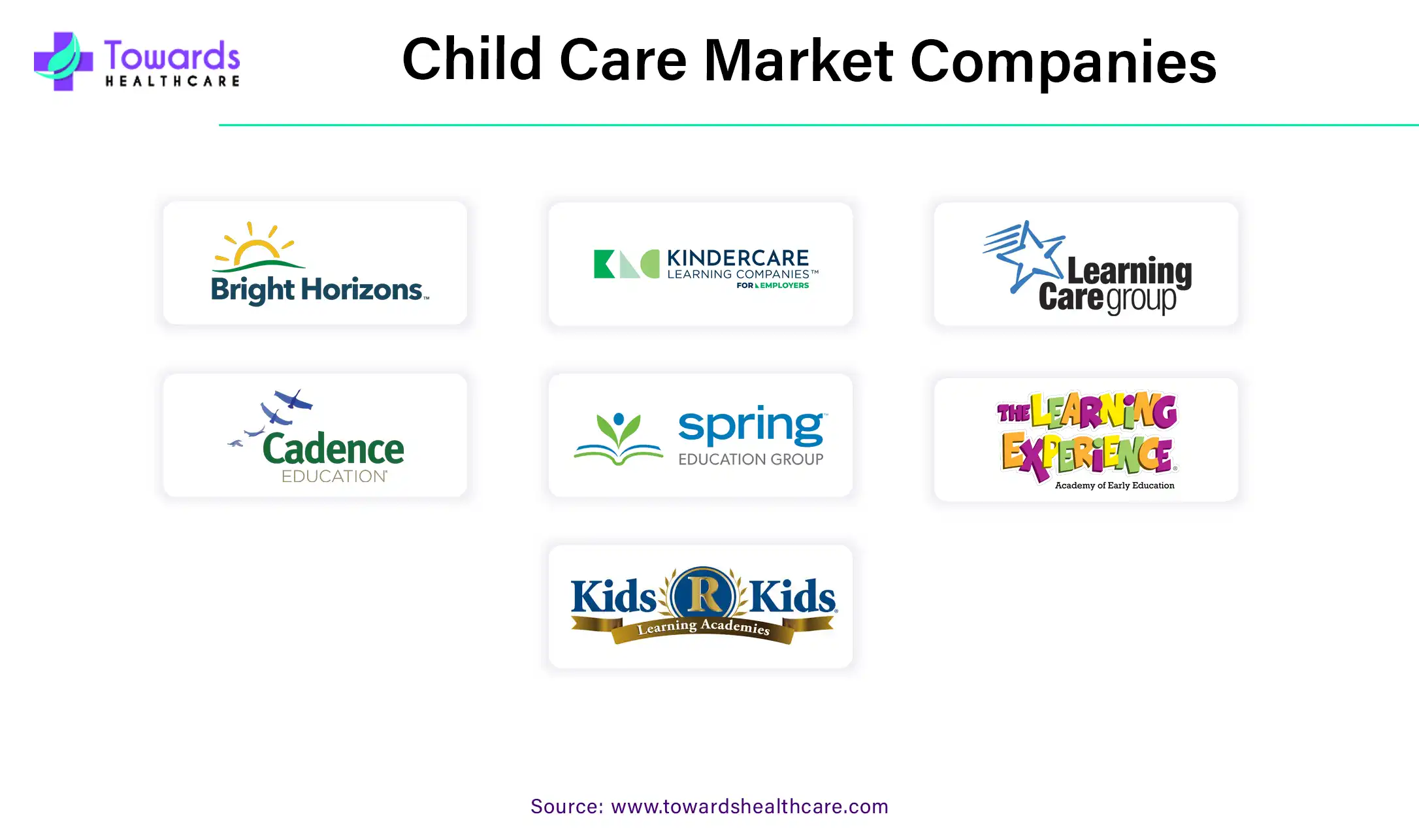
| Company Name | Kindercare Learning Centers, LLC. |
| Headquarters | U.S., North America |
| Recent Development | In September 2024, the parameters of the IPO were revealed by KinderCare Learning Companies, the biggest private supplier of early childhood education and care services in the United States. Offering 24 million shares at a price between $23 and $27, the Lake Oswego, OR-based firm hopes to raise $600 million. The fully diluted market value of KinderCare Learning Companies would be $2.9 billion at the halfway point of the suggested range. |
| Company Name | Foresight Group |
| Headquarters | UK, Europe |
| Recent Development |
In March 2024, an inventive and multi-award-winning children's entertainment facility and daycare center will get a £5 million investment from Foresight Group, a top regional private equity and infrastructure investment company. |
By Type
By Delivery
By Age Group
By Region
December 2025
December 2025
December 2025
December 2025